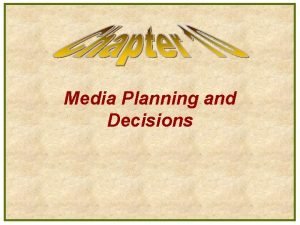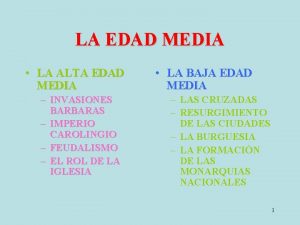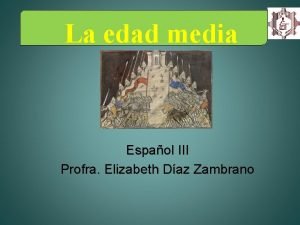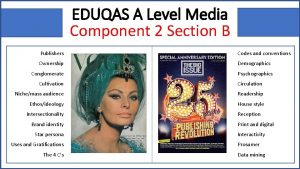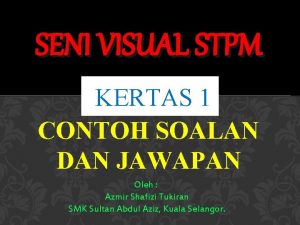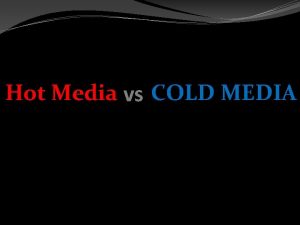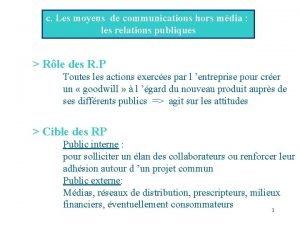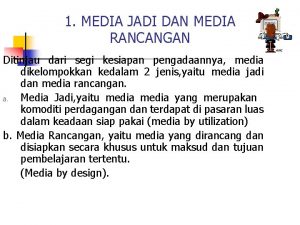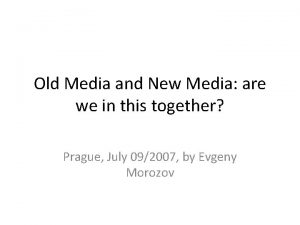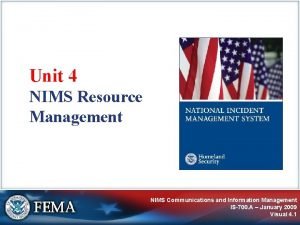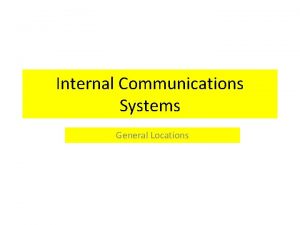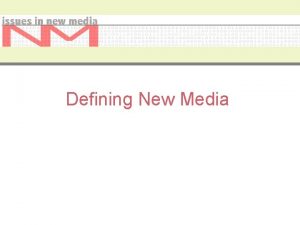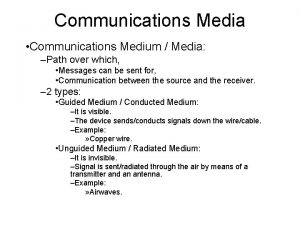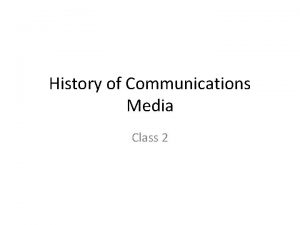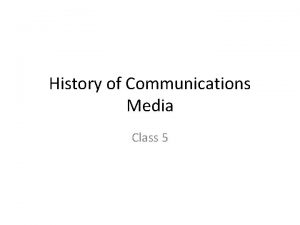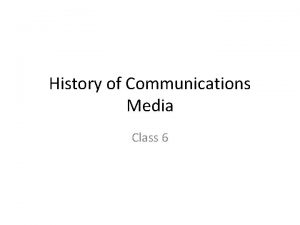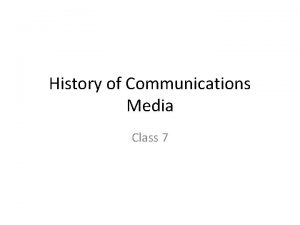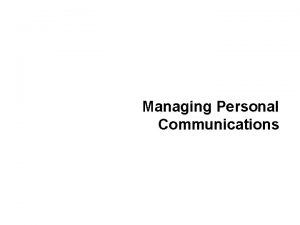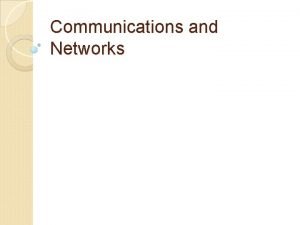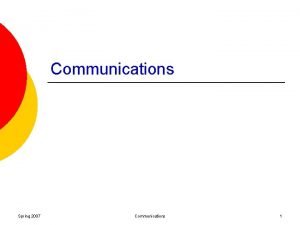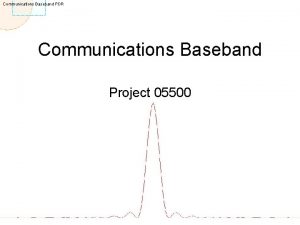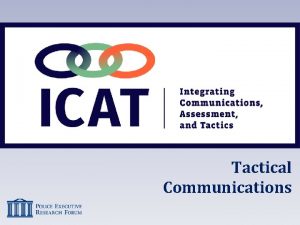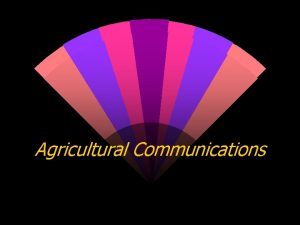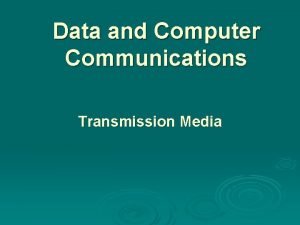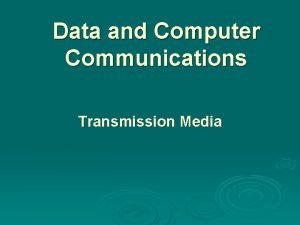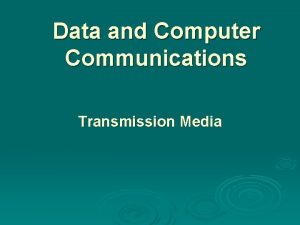History of Communications Media 1 History of Communications















![History of Communications Media • Data – [n] a collection of facts from which History of Communications Media • Data – [n] a collection of facts from which](https://slidetodoc.com/presentation_image_h/065cfe7b298996c296555f5cc53c0930/image-16.jpg)
![History of Communications Media • Motion Picture – [n] a form of entertainment that History of Communications Media • Motion Picture – [n] a form of entertainment that](https://slidetodoc.com/presentation_image_h/065cfe7b298996c296555f5cc53c0930/image-17.jpg)
![History of Communications Media • Message – [n] a communication (usually brief) that is History of Communications Media • Message – [n] a communication (usually brief) that is](https://slidetodoc.com/presentation_image_h/065cfe7b298996c296555f5cc53c0930/image-18.jpg)



























- Slides: 45

History of Communications Media 1

History of Communications Media • Outline of Course – Question – Why Study the History of Media? – Key Definitions – Some Notes About: • Information • Human Perception and Communication • Pre-literate Cultures – The Impacts of Literacy – The Impact of Printing 2

History of Communications Media • Outline of Course – 2 – The 19 th Century Media Revolution • • • Printing Innovations & their Consequences Photography Telegraph Telephone Motion Pictures – The 20 th Century Media Revolution • • • Radio Television Xerox Machine Computers & the Internet Cellphones 3

Why is the Study of Media Important? – To a large extent, who we are now is the product of our memories of the past • Increasingly our memories of key events consist of media images and accounts – Different media have different intrinsic defining characteristics in terms of: • What type(s) of information or message they can convey • How well they can convey it • The speed, completeness, and accuracy with which they can convey it • How recipients receive, assimilate, and react to the information 4

Why is the Study of Media Important? - 2 – As communication theorists and historians point out, changes in the mode of communication cause changes in the culture • Media like other technologies have multiple impacts – Obsoletes other technologies or relegates them from a dominant technology to a niche – Often raises new issues and problems after larges-scale adoption – Often upsets existing distributions of wealth, power, and status » Empowers some (often new) groups and diminishes the power of others – Gives rise to new social institutions to deal with the new issues and problems 5

Why is the Study of Media Important? 3 – Media also differ in such socially relevant impacts as: • The number and types of people who can access the media as either message/information senders or message/information recipients. This reflects: – – Cost of the media Technological sophistication required Ease of use The ease or difficulty with which society or the government can control access and/or content 6

History of Communications Media • Information – What is it? – The term has several definitions because it is a term that embraces many different things – We will get into the various definitions during this course – We will start out by looking at two different perspectives of what it consists of 7

History of Communications Media • Information – What does it consist of? - 1 – Fact – a unique bit of information that identifies an object, person, place, or date – Concept – a category of items or ideas that share common features – Procedure – a series of steps that show to make or do something – Process – a description of how something works or operates – Principles – rules or criteria that predict an outcome 8

History of Communications Media • Information – what does it consist of? - 2 – From an individual perspective, it consists of 5 rings of data, ideas, and knowledge 9

History of Communications Media • Information – what does it consist of? - 3 – Internal information – the messages that run our body’s internal systems and enable them to function 10

History of Communications Media • Information – what does it consist of? - 4 – Conversational information – the messages we get from the formal presentations and informal conversations that we have with the people around us 11

History of Communications Media • Information – what does it consist of? – 5 – Reference information – information and data about the physical world around us • Includes what we know from science and technology • Includes the content stored in our reference media 12

History of Communications Media • News information – information and data about recent events – It consists of information transmitted via the media about the people, places, and events that engage us, influence our view of the world, or even directly affect our lives 13

History of Communications Media • Cultural information – the knowledge and experience gained from our attempt to understand come to terms with our civilization. – Information from the other rings is incorporated here to build the body of knowledge and culture that influences the society as a whole and our individual attitudes and beliefs. – It encompasses history, philosophy, and the arts 14

History of Communications Media • Content – This term also has several definitions: – The two most relevant are: • [n] something (a person or object or scene) selected by someone for representation • [n] what a communication that is about something is about 15
![History of Communications Media Data n a collection of facts from which History of Communications Media • Data – [n] a collection of facts from which](https://slidetodoc.com/presentation_image_h/065cfe7b298996c296555f5cc53c0930/image-16.jpg)
History of Communications Media • Data – [n] a collection of facts from which conclusions may be drawn; "statistical data" • Knowledge – [n] the psychological result of perception and learning and reasoning • News – [n] new information about specific and timely events; "they awaited news of the outcome" – [n] new information of any kind; "it was news to me" – [n] information reported in a newspaper or news magazine; "the news of my death was greatly exaggerated 16
![History of Communications Media Motion Picture n a form of entertainment that History of Communications Media • Motion Picture – [n] a form of entertainment that](https://slidetodoc.com/presentation_image_h/065cfe7b298996c296555f5cc53c0930/image-17.jpg)
History of Communications Media • Motion Picture – [n] a form of entertainment that enacts a story by a sequence of images giving the illusion of continuous movement • Broadcast – [n] message that is transmitted by radio or television – [n] a radio or television show; "did you see his program last night? " 17
![History of Communications Media Message n a communication usually brief that is History of Communications Media • Message – [n] a communication (usually brief) that is](https://slidetodoc.com/presentation_image_h/065cfe7b298996c296555f5cc53c0930/image-18.jpg)
History of Communications Media • Message – [n] a communication (usually brief) that is written or spoken or signaled – [n] what a communication that is about something is about 18

History of Communications Media • The Human Brain and Information – Information originates in the combination of sense perceptions and data stored in human memory. • Recall of related information in memory • Recognition and storage in short-term memory • Linking to other memories – By combining sense perceptions with knowledge in long-term memory, the brain creates new knowledge 19

History of Communications Media • The Human Brain and Information – 2 – The brain seems to have different systems for integrating image input data and other sensory input data with information or knowledge structures in long-term memory • One consequence is that we have a memory for pictorial images that greatly exceed our memory for words or names. 20

History of Communications Media • Information can be broken down into 4 basic categories – Semantic – Visual – Conceptual – Procedural • These categories have distinct implications for use, learning, teaching, and communication 21

History of Communications Media • Semantic information consists of symbols such as words, names, and numbers – Can represent things, persons, places, actions, or states of being – Semantic symbols have no direct link to the objects signified – They can be combined via language syntax to describe present, past, future, actual, conditional, or imaginary realities 22

History of Communications Media • Visual information consists of information in the form of visual or pictorial representations of real and/or imaginary person(s), place(s), or thing(s) 23

History of Communications Media • Notes about Concepts – Can be either abstract or perceptual – Have a prototype or best example – Have three levels • Superordinate • Basic • Subordinate – Expressed in the form of verbal information 24

History of Communications Media • The history of media can be broken down into five eras: 1. Non-literate cultures – • • Characterized human societies prior to writing and also the illiterate peasants and lower classes in many cultures Oral & locality-based cultures 2. Manuscript cultures • • Characterized societies prior to printing in which literacy was restricted to a small elite Primarily an oral & locality-based culture, but with filtering down of literate culture 25

History of Communications Media 3. Printing cultures • • • Characterized alphabet societies after the invention of printing Primarily a print culture, although many elements of an oral culture persist The book, pamphlet, professional journal, and later the newspaper and magazine provide people with some knowledge of the outside world 26

History of Communications Media 4. Media-influenced cultures • Characterized a 19 th and early-20 th century culture influenced by the telegraph, the telephone, and a railroad & post office system able to deliver mail and printed material (including newspapers) over vast areas at reasonable speed 5. Media-dominated cultures • Characterized a 20 th century culture in which radio, television, and later the computer/Internet become dominant influences 27

History of Communications Media • Non-literate societies – • • – – • • • Information input is largely local via Personal observation What one hears from neighbors and elders A good memory is highly valued Most knowledge is some form of rhyme and poetry Learning consists of rote memorization and learning by apprenticeship, sometimes with the aid of art Knowledge Its preservation consists of reciting in front of elders and fellow villagers Often lost over time Held in common 28

History of Communications Media • Writing – the first communications media – Writing first grew out of the need to inventory agricultural surpluses. • This required measurement and designation of ownership – Writing evolved as merchants and priests/scribes used different clay tokens to represent different quantities and commodities 29

History of Communications Media • Writing – the first communications media - 2 – 3 Types of writing systems • Logographic – one symbol for each word or morpheme (e. g. Chinese, Mayan glyphs, & Egyptian hieroglyphics) • Syllabic – one symbol for each syllable (e. g. Japanese kana, Mesopotamian cuneiform , & Linear B of Mycenean Greece) • Alphabet – one symbol for each sound or phoneme (e. g. Latin, Greek, Cyrillic, Hebrew, Arabic) 30

History of Communications Media • Notes about writing systems – No actual writing system employs one type of writing exclusively • English uses many logograms – numbers, $, %, &, and @ are common English logograms • Egyptian hieroglyphics used pictograms, but Egyptian pictograms also stood for sounds as well as the things they were images of – Semitic-speaking persons picked up the system and stripped it down to pure symbols of sound in the form of the alphabet 31

History of Communications Media • Notes about writing systems -2 – Writing systems arose in Mesopotamia before 3000 BC, in Egypt c 3000 BC, in China by 1300 BC, and in Mexico before 600 BC – The first type of writing system was the logographic, then the syllabic, and finally the alphabet – Early writing was limited to the professional scribes in the employ of the king or the temple priests 32

History of Communications Media • Notes about Chinese writing – All Chinese dialects use the same script – Chinese script reflects • • Pictorial representation Use of diagrams Use of one symbol to suggest another Combination of signification and phonetics – There are over 50, 000 symbols in a Chinese dictionary • About a 1, 000 symbols count for about 90% of Chinese writing 33

History of Communications Media • The Alphabet – First alphabet originated c 1800 -1900 BC by Semitic peoples living in Egypt – Apparently originated as a kind of shorthand for taking dictation – Hebrew and other semetic languages did not and do not have letters for vowels • if we were to follow Hebrew usage in English we would write and print 'cnsnts' for 'consonants'. – The Greeks developed the first alphabet with vowels 34

History of Communications Media • What the alphabet did -1 – Made possible the creation of lists – Converted traditional knowledge into an external object both available for inspection and no longer dependent on memory – Led to the concept of history – Led to the bifurcation of culture into a “high” culture based on literacy and a “low” culture of the illiterate 35

History of Communications Media • What the alphabet did - 2 – Affected the way the Greeks saw the physical world • Led the Greeks to see the material world as analogous to the alphabetic process – Made eventually possible the modern expansion of literacy and democracy – Led to the development of law as a regulator of human behavior in place of oral custom and taboo 36

History of Communications Media • Ideographic vis-a-vis Alphabet Cultures – 1 – The different historical paths that China and the West followed are to some extent a logical corollary of their different writing systems • In China, ideographic literacy and the related study of the Confucian classics – Created a common, largely-closed oligarchic elite » That was spread all over China and » Whose members had more in common with each other than they did with the non-literate speakers of the local Chinese dialect among whom they lived – Fostered a strong cultural conservatism 37

History of Communications Media • Ideographic vis-à-vis Alphabet Cultures – 2 • In the West, alphabetic literacy had more diverse effects – In the manuscript cultures of the Roman Empire and Medieval Europe, there existed a literate Latin-speaking elite with an identity that was separate from the illiterate locals who spoke only local languages and did not speak Latin » But this elite was more open and more diverse since it embraced government officials, military officers, clerics, and merchants – With printing, it gave each vernacular language a written form » The consciousness of speaking and writing a distinct language helped foster an ethnocentrism and nationalism that led to fractured lands, fractious governments, and schismatic religions 38

History of Communications Media • Different Types of Writing Media - 1 – Stone – Was permanent but not transportable – Clay Tablet – Had to be written upon before the tablet hardened. Long-lasting but fragile – Papyrus – Was light in weight; relatively cheap; easily transportable; suitable for both writing and drawing pictures; suitable for scrolls, but could be supplied only by Egypt – Parchment – Was relatively durable and long-lasting; suitable for codex books that contained both writing and drawing; expensive to manufacture, but could be produced anywhere since it was made from animal skins 39

History of Communications Media • Different Types of Writing Media – 2 – Rag Paper – Was considerably cheaper than parchment, because it was relatively easy to produce; made a good writing and drawing media; turned out to be a superior media for printing; relatively longlasting and easily portable – Wood Pulp Paper – Was cheaper than rag paper, thus replacing rag paper in cheaper books and newsprint; not a very long lasting media due to its tendency to degrade as a result of acidification. 19 th century invention 40

History of Communications Media • Rag Paper - 1 – Manufactured by taking linen and cotton rags, wetting them and letting them mold, pounding the rags until their threads become unwoven, soaking them in giant vats, straining the resulting pulp through a sieve-like mold, and then hanging the paper up to dry – Invented in China c 105 AD; its manufacture spread into Islamic areas with the Islamic capture of Turkestan in 751 and reached Europe c 1275. 41

History of Communications Media • Rag Paper – 2 – Unlike parchment which could be produced over wide areas, paper manufacturing took place in cities with plentiful supplies of water and water power. In such cities, there were both cheap supplies of rags and markets for the paper – Paper had the following effects in Europe: • It helped move learning and education from rural monasteries to the new urban schools and universities • It encouraged merchants and traders to become literate in their native vernacular language in order to create and keep needed accounts and records. • Paper led to the creation of a body of manuscripts in the vernacular as well as in Latin 42

History of Communications Media • Manuscript cultures – A high literate culture and a low village culture – Texts tended to be read aloud even to those who could read – Letters and documents were quasi-public – Writing served as input into the oral world – Manuscripts had incipits and chapter/verse designations rather than titles or page numbers 43

History of Communications Media • Manuscript cultures – 2 – Books are treasured items – The manuscript book had interesting corollaries – Word separation and punctuation of text did not become standard until the later Middle Ages – The sermon and public readings served as news dissemination media – What was ancient was venerated 44

History of Communications Media • The Impact of Printing 45
 Msa agar selective or differential
Msa agar selective or differential Apa yang dimaksud dengan
Apa yang dimaksud dengan Gross rating points
Gross rating points People as media and people in media
People as media and people in media Invasiones en la alta edad media
Invasiones en la alta edad media Alta edad media y baja edad media
Alta edad media y baja edad media Media hot and cold
Media hot and cold Staphylococcus aureus eosin methylene blue agar
Staphylococcus aureus eosin methylene blue agar A level media component 2
A level media component 2 Contoh soalan seni visual stpm penggal 2
Contoh soalan seni visual stpm penggal 2 Hot media and cold media
Hot media and cold media Moyens hors médias
Moyens hors médias Wired data transfer
Wired data transfer Media jadi dan media rancangan
Media jadi dan media rancangan Hot cold media
Hot cold media New media vs old media
New media vs old media History also history physical
History also history physical Crisis communications working group
Crisis communications working group Times fiber communications
Times fiber communications Nims communications and information management
Nims communications and information management Means communication at a distance
Means communication at a distance 113-571-1022
113-571-1022 Perform voice communications 113-com-1022
Perform voice communications 113-com-1022 Communications mix
Communications mix Oracle communications services gatekeeper
Oracle communications services gatekeeper Sipfoundry
Sipfoundry Open platform communications unified architecture
Open platform communications unified architecture Ncas introduction
Ncas introduction Ministry of transport, communications and works
Ministry of transport, communications and works Bioinformatics toolbox matlab
Bioinformatics toolbox matlab Encoding in advertising
Encoding in advertising Objectives of marketing communication
Objectives of marketing communication Push pull profile strategies marketing communications
Push pull profile strategies marketing communications Utility communications market analysis
Utility communications market analysis Internal communications system
Internal communications system Promotion tools from the marketing communication mix
Promotion tools from the marketing communication mix Btl communications
Btl communications Open source unified communications
Open source unified communications Integrated marketing communications definition
Integrated marketing communications definition Idaho state ems
Idaho state ems Slappey communications
Slappey communications Global marketing communications
Global marketing communications Employee relations communications
Employee relations communications Oma-dm client high cpu
Oma-dm client high cpu Live communication server
Live communication server Data and computer communications 10th edition
Data and computer communications 10th edition


